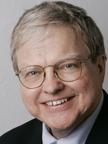From the Associated Press
For nearly five decades, Marty Crutsinger has played a vital role at the Associated Press, chronicling a gallery of transformative events.
A reporter known for his steady nerves, breadth of knowledge and boundless energy, Marty chased stories that brought him to extraordinary moments in history.
From plane crashes, hurricanes and cruise-ship fires in Miami to Mikhail Gorbachev’s first appearance at a Group of Seven global meeting in London, fromcoverage of city hall to the statehouse to U.S. Department ofTreasury and the Federal Reserve, Marty’s career has hop-scotched across a half-century of assignments that required smarts, versatility and quick-thinking ingenuity.
Now, his distinguished 50-year career, 48 years of which were spent as a dear colleague to hundreds of AP journalists across the world, is reaching its end. Marty will be retiring on Dec. 10, affording him the opportunity – finally – to enjoy uninterrupted stretches of time with his family.
A well-deserved retirement it is. Marty’s career has long benefited the AP colleagues who drew from his expertise and generosity of spirit. Yet the pleasure ran both ways: Marty would surely agree that he has experienced the kinds of indelible moments that many of us had envisioned when we embarked on a career in journalism.
His early reporting ranged from a taste of government (the Florida state legislature) to the horrific (the Ted Bundy murders and the Jim Jones-led mass suicides) to the shocking (the 1981 attempted assassination of President Ronald Reagan) to the classic Washington scandal (James Watt’s self-destruction as the bigotry-spewing Reagan Interior Secretary – result of a Crutsinger scoop!). From the Carter administration to the Biden administration, Marty’s reporting has served a couple of generations of AP readers, viewers and listeners.
For the past 37 years, Marty has been a leading chronicler of economics, with a mix of assignments that comprised the Treasury and the Fed as they defused financial catastrophes; meetings of global finance leaders; and dozens of market-moving economic indicators. Marty’s reporting tenure spanned five Fed leaders from Paul Volcker to Jerome Powell and 13 Treasury secretaries from Donald Regan to Janet Yellen.
When the 2008 financial crisis threatened to topple the entire banking system, Marty labored from the Treasury press room nearly every weekend, ricocheting from the government’s takeover of Fannie Mae and Freddie Mac to Lehman Brothers’ collapse to the day Treasury Secretary Henry Paulson summoned the executives of America’s biggest banks to press them to accept government aid packages to avoid inciting panic at any one bank and to thereby protect the entire financial system.
Several years ago, the Economics team in Business News worked with Marty to create a video to capture the evolution of Fed leaders Marty had covered since 1984. That two-minute video, narrated by Marty himself and aptly titled “The Crutsinger Chronicles,” is itself a gem of concise reporting.
Perhaps nothing has better symbolized Marty’s value to the AP than his iron-man reliability: Starting more than three decades ago, not once did Marty miss an assignment to cover one of the numerous economic indicators that he handled each month at early-morning sessions at the Labor or Commerce Department. Not once.
For all his qualities as a reporter – dependability, expertise, institutional knowledge – Marty will most be missed as a friend and colleague.
In Marty’s own words:
I graduated from the University of Texas in August 1971 with a degree in government, which has been useful since I have spent the last 50 years covering all types of government.
But by far the most valuable courses I took at UT were in the Journalism school. I used my electives to take every course I could in journalism and learned the tools of my trade from some great professors, led by Griff Singer.
I also started working on the Daily Texan in the summer of 1970, working as a general assignment reporter.
Given that it was the summer semester, there were not a lot of us around so I got to do some amazing things quickly. I found myself interviewing Chancellor Harry Hunt Ransom in his massive office in the tower for a front-page story in the Texan. I was hooked on journalism.
Over the next year, I served as a reporter on the Texan and as editor for the wire page at The Texan, spending many late nights down in the composing room as a very talented crew patiently fixed my composing mistakes.
In many ways I owe my entire career to UT and the Texan. Not only did I learn how to report and write, but I also made friendships that have helped me through the years. John Reetz, Cyndi Taylor, Cliff Avery, Cicely Wynne and John Pope were all in that group of Texan staffers.
When I was about to graduate in the summer of 1971 with slim job prospects, Ken Gepfert, my teaching assistant in one of Griff’s reporting classes, said he would call his old newspaper to see if they had any openings.
And based on Ken’s recommendations, they hired me sight unseen. I loaded up my 1961 Chevrolet Impala and headed to my first job, covering city hall for the Jacksonville Journal, the afternoon newspaper in Jacksonville, Fla.
When Ken graduated, he took a job with the AP in Miami and with his help, I got hired to work for the AP in Miami in April 1973. I learned a lot from Reid Miller, my first bureau chief and as I always like to say, my best bureau chief. Reid transferred me to Tallahassee to cover Florida state government in 1975 and then brought me to Washington in 1978 after he became deputy bureau chief there.
And Washington is where I have been ever since, covering eight presidents, five Federal Reserve chairs including all 18 years that Alan Greenspan had the job and 13 Treasury secretaries, getting to cover Janet Yellen when she was the first woman Fed chair and now as the first female Treasury secretary.
Over the years, I have interviewed a lot of government officials despite the fact that I blew my first chance to interview a president. Well, Lyndon Johnson was actually a former president when I got my chance to cover him. I was in the Texan newsroom one day when we heard that Johnson was making a surprise appearance on the UT campus. I rushed over to the event and even though I arrive late I was able to get enough notes to write a story.
I had not noticed Johnson in the room until I got up to leave and there he was standing at the back of the hall. It was my one and only time to experience the LBJ stare. To me, it seemed like his eyes were boring right through me. It so rattled me that any thought of asking him a question just evaporated. Luckily for me, I did get better at asking questions since my encounter with LBJ.
